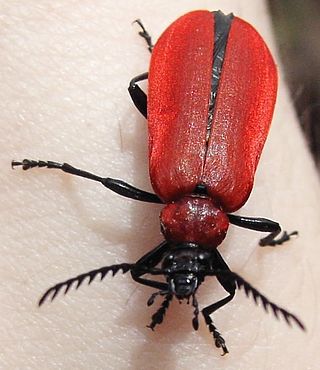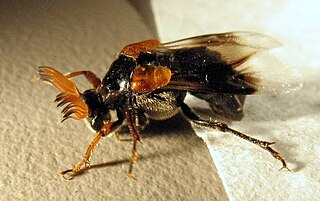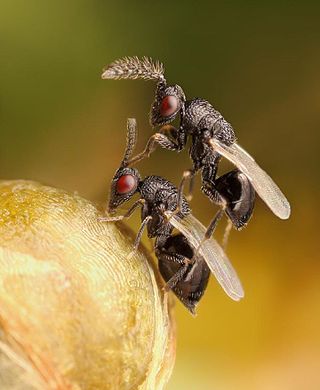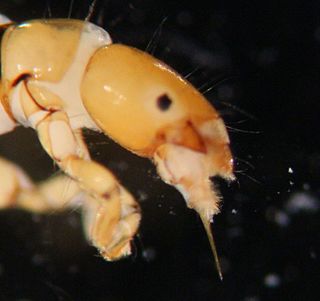
Chalcid wasps are insects within the superfamily Chalcidoidea, part of the order Hymenoptera. The superfamily contains some 22,500 known species, and an estimated total diversity of more than 500,000 species, meaning the vast majority have yet to be discovered and described. The name "chalcid" is often confused with the name "chalcidid", though the latter refers strictly to one constituent family, the Chalcididae, rather than the superfamily as a whole; accordingly, most recent publications (e.g.,) use the name "chalcidoid" when referring to members of the superfamily.

Fire-coloured beetles is the common name for members of the tenebrionoid family Pyrochroidae. The family is found worldwide, and is most diverse at temperate latitudes. Adults measure 2–20 millimetres (0.079–0.787 in); larvae reach 35 millimetres (1.4 in). Larvae of Pyrochroinae are found associated with the bark of dead trees. They are probably mostly fungivorous, although they may become cannibalistic if too crowded.

Chaoboridae, commonly known as phantom midges or glassworms, is a family of fairly common midges with a cosmopolitan distribution. They are closely related to the Corethrellidae and Chironomidae; the adults are differentiated through peculiarities in wing venation.

The family Pythidae is a small group of tenebrionoid beetles with no vernacular common name, though recent authors have coined the name dead log bark beetles. There are seven genera, which are largely native to the mid-high latitude regions of the Northern Hemisphere and Australia, with one genus also present in the tropical Americas. The larvae are generally found with decaying vegetation and wood on which they feed, while adults are not associated with the larvae and are generally caught using malaise traps and light traps.

Ripiphoridae is a cosmopolitan family of some 450 described species of beetles sometimes called "wedge-shaped beetles". Ripiphoridae are unusual among beetle families in that many species are hypermetamorphic parasitoids, an attribute that they share with the Meloidae. Members of the family differ in their choice of hosts, but most attack various species of bees or wasps, while some others attack cockroaches or beetles. Many species of Ripiphoridae have abbreviated elytra, and flabellate or pectinate antennae.

The Eucharitidae are a family of parasitic wasps. Eucharitid wasps are members of the superfamily Chalcidoidea and consist of three subfamilies: Oraseminae, Eucharitinae, and Gollumiellinae. Most of the 55 genera and 417 species of Eucharitidae are members of the subfamilies Oraseminae and Eucharitinae, and are found in tropical regions of the world.

The Leucospidae are a specialized group of wasps within the superfamily Chalcidoidea, that are ectoparasitoids of aculeate wasps or bees. They are typically mimics of bees or stinging wasps, often black with yellow, red, or white markings, sometimes metallic, with a robust mesosoma and very strong sculpturing. The hind femora are often greatly enlarged, with a row of teeth or serrations along the lower margin as in Chalcididae. The wing has a longitudinal fold. The female ovipositor is sometimes short, but if not, it is recurved and lies along the dorsal side of the metasoma, a unique feature. The males are also unusual, in the fusion of many of the metasomal segments to form a capsule-like "carapace".

The Eurytomidae are a family within the superfamily Chalcidoidea.

Dipseudopsidae is a family of caddisflies in the order Trichoptera. There are about 6 genera and at least 110 described species in Dipseudopsidae.

Nemestrinidae, or tangle-veined flies is a family of flies in the superfamily Nemestrinoidea, closely related to Acroceridae. The family is small but distributed worldwide, with about 300 species in 34 genera. Larvae are endoparasitoids of either grasshoppers (Trichopsideinae) or scarab beetles (Hirmoneurinae). Some are considered important in the control of grasshopper populations. Adults are often observed on flowers.

Campopleginae is a large subfamily of the parasitoid wasp family Ichneumonidae with a world-wide distribution. Species in this subfamily have been used in the biological control of the alfalfa weevil, clover weevil, various species of Heliothis, oriental army worm, European corn borer, larch sawfly, and others.

Mesochorinae is a worldwide subfamily of the parasitic wasp family Ichneumonidae.

Kateretidae also known as short-winged flower beetles are a family of beetles in the superfamily Cucujoidea. There are 10 extant and 4 extinct genera, and at least 40 described species. They are found worldwide except in New Zealand. Adults are anthophagous, feeding on flowers, while the larvae are spermatophagous inside the flower corolla.

The Euphorinae are a large subfamily of Braconidae parasitoid wasps. Some species have been used for biological pest control. They are sister group to the Meteorinae.

Brachycentridae is a family of humpless casemaker caddisflies in the order Trichoptera. It is found in North America, Europe, and Asia. Georg Ulmer first described it in Germany in 1903 as a subfamily of Sericostomatidae. The type genus for Brachycentridae is Brachycentrus J. Curtis, 1834.

The Alysiinae are a subfamily of braconid parasitoid wasps with over 1000 described species. Several species have been used in biocontrol programs. They are closely related to the Opiinae.

The Rogadinae are a large subfamily of braconid parasitoid wasps. Several Rogadinae species parasitize pest caterpillars and are important for naturally occurring biological control.

Euperilampus is a genus of chalcid wasps in the family Perilampidae. There are about 18 described species in Euperilampus.

Eucharitinae is a subfamily of chalcid wasps in the family Eucharitidae.
Oraseminae is a subfamily of chalcid wasps in the family Eucharitidae. There are at least 10 genera in Oraseminae.





















